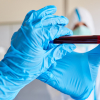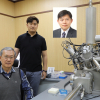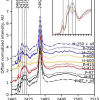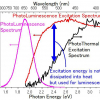Spectroscopy News
Using a smartphone camera and spectral super-resolution spectroscopy, anaemia and blood disorders can be assessed outside the lab.
The interplanar bond strength of graphene has been evaluated by measuring the elastic constant of graphite, demonstrating that the elastic constant of monocrystalline graphite was above 45 GPa, higher than conventionally believed.
Synchrotron-generated X-rays can be used to probe what happens when liquids solidify into disordered solids, a process that has puzzled physicists for decades.
Bruker is partnering with the Australian National Phenome Centre which has launched a major research and diagnostics project to better understand COVID-19.
The COVID-19 MS Coalition of more than 500 scientists from around the world has been created to share data on COVID-19 gleaned from the use of mass spectrometry techniques to examine people’s blood and other biomarkers.
Researchers from Daegu Gyeongbuk Institute of Science and Technology have used SIMS to visualise up to tens of different proteins simultaneously in the same cell.
A sandwich of molybdenum, sulfur and selenium turns out to be well suited as a SERS substrate.
XANES has helped explain how ultramarine paint was traditionally made and offered an insight into the problem of “ultramarine disease” suffered by some paintings.
The multiplexed enhanced protein dynamics (mePROD) mass spectrometry method helps show how a SARS-CoV-2 infection changes the human host cells.
A type of photothermal spectroscopy is being used to measure thermal energy to understand more about the processes of energy-converting systems like leaves during photosynthesis.
Researchers from the University of Konstanz have observed in real time the molecular processes that take place at DNA strand breaks by means of infrared spectroscopy.
Congratulations to Yuki Ozaki on the announcement of his latest award.
Södra, a pulp producer in Sweden, is installing its second FITNIR analyser for online pulp liquor monitoring.
Every year, the WITec Paper Award competition recognises three exceptional peer-reviewed publications that feature results acquired with a WITec microscope.The 2020 Paper Awards go to researchers from Japan, Poland and Austria.
Using gas cluster ion beam secondary ion mass spectrometry (GCIB-SIMS), researchers at Penn State have directly observed functional enzyme clusters (metabolons) involved in generating purines, the most abundant cellular metabolites.
SCIEX and Intabio are working to couple the Blaze imaged capillary isoelectric focusing with mass spectrometry system with SCIEX high-resolution accurate mass spectrometers.
Applications are invited for these prestigious awards administered by the Association of British Spectroscopists (ABS) Trust.
A team of researchers from the Fraunhofer Institute for Applied Optics and Precision Engineering IOF in Jena has developed a quantum imaging solution that can produce detailed insights into tissue samples using extreme spectral ranges and less light.
The authenticity of one of the world’s most expensive edible oils, argan oil, can be tested with benchtop NMR spectroscopy.
Individual ion mass spectrometry (I2MS) can determine the exact mass of a huge range of intact proteins. It analyses the mass of each and every molecule on an individual basis.

















